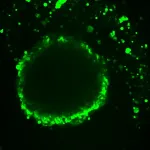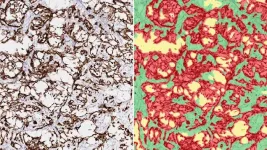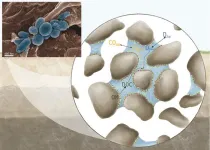(Press-News.org) Using 3-D models of ovarian cancer tumors, scientists found differences in gene activity based on where a cell is in a tumor, demonstrating how a cell’s location and environment in a cancerous tumor can strongly influence which genes are active and the cell’s role in the cancer’s biology. More specifically, the team co-led by researchers at the National Center for Advancing Translational Sciences (NCATS), part of the National Institutes of Health, showed that gene activity in cells at or near a tumor’s surface differed from that of cells closer to the tumor center.
The approach pairs the use of a technology to reveal the genetic activity of single cells within a tumor with fluorescent dyes that spread into tumors. The work could allow researchers to study how the same diseases can vary in people and progress differently. This research could help clinicians identify treatment strategies focused on specific areas in tumors, which could lead to better therapies for cancers and other diseases. The team reported its results June 21 in Cell Systems.
“It’s commonly accepted that a cell’s location and surrounding environment influence the cell’s identity,” said Craig Thomas, Ph.D., a translational scientist at NCATS. “Two cells can be genetically identical but have different cellular identities, meaning different genes are turned on because of their location and environment. Our goal was to establish a straightforward method to study this concept in multiple settings.”
The new system, called Segmentation by Exogenous Perfusion, or SEEP, takes advantage of a dye that diffuses into cells throughout a tumor at a definable rate. Measuring how much dye gets into individual tumor cells provides information on the cell’s location, and specifically, its access to the outside environment. Using computational methods, the researchers linked this information to cells’ gene activity, allowing the scientists to connect the cells’ identities with their location.
“Understanding the relation of cells to each other and the effects of their positions in space has been a fundamental question in cancer, neurological disorders and other areas,” said co-author Tuomas Knowles, Ph.D., at the University of Cambridge.
In the work, researchers used three types of 3-D laboratory models – spheroids, organoids and mouse models – created from human ovarian cancer cells. Spheroids are 3-D clusters of cells grown in a lab dish that can mimic some traits of organs and tissues. Organoids, also grown in a dish, are more complex 3-D models that more closely mimic organ and tissue function and structure. In the mouse models, researchers implanted human ovarian cancer cells to form tumors.
“It’s critical to understand that not every cell in a tumor will be exposed to a drug in the same way,” Knowles said. “A cancer drug might kill the cells on the surface of a tumor, but the cells in the middle are different and affected differently. That’s likely contributing to why some therapies fail.”
The SEEP method revealed that tumor cells near the tumor surface were more likely to undergo cell division than cells closer to the tumor center. Cells on the surface of tumors also turn on genes to protect them from immune system responses. Not surprisingly, these gene responses are linked to how the tumor hides from the body’s immune defenses.
Researchers were surprised at the differences in gene activity between cells on or near the surface and those farther inside the ovarian cancer tumor models. The findings could help scientists better understand how tumors are structured. Such information could lead to improved treatments. One possible cancer treatment method could be to target cells likely to be affected in different areas of tumors.
“Certain tumor cell types are susceptible to certain therapies,” noted first author and Harvard University medical student David Morse, Ph.D. “Knowing where cells are located and their levels of accessibility in the tumor could help us decide how to use drugs in combination. It could help tell us how long to give a drug and when to move on to other therapies.”
The NIH research was supported by NCATS’ Division of Preclinical Innovation and the National Cancer Institute’s Center for Cancer Research. Work at Harvard University was funded by the National Science Foundation (DMR-1708729) and through the Harvard Materials Research Science and Engineering Center (DMR-2011754). The research at Cambridge University was supported by the Biotechnology and Biological Sciences Research Council, the Newman Foundation, the Wellcome Trust, and the European Research Council under the European Union’s Seventh Framework Program (FP7/2007–2013) through the European Research Council grant PhysProt (agreement no. 337969). There also was support by the NIH Oxford–Cambridge Scholars Program and the Certara Biomedical Research Scholarship.
Reference: DB Morse, et al. Positional influence on cellular transcriptional identity revealed through spatially segmented single-cell transcriptomics. Cell Systems DOI: https://doi.org/10.1016/j.cels.2023.05.003
About the National Center for Advancing Translational Sciences (NCATS): NCATS conducts and supports research on the science and operation of translation — the process by which interventions to improve health are developed and implemented — to allow more treatments to get to more patients more quickly. For more information about how NCATS helps shorten the journey from scientific observation to clinical intervention, visit https://ncats.nih.gov.
About the National Institutes of Health (NIH): NIH, the nation’s medical research agency, includes 27 Institutes and Centers and is a component of the U.S. Department of Health and Human Services. NIH is the primary federal agency conducting and supporting basic, clinical and translational medical research, and is investigating the causes, treatments and cures for both common and rare diseases. For more information about NIH and its programs, visit https://www.nih.gov.
NIH…Turning Discovery Into Health®
END
Reston, VA—Leaders from 12 nuclear medicine organizations around the world have issued a white paper about the challenges and opportunities in theranostics education. Published in the June issue of The Journal of Nuclear Medicine, the report outlines the current theranostic educational and accreditation offerings across the globe. It also provides guidelines to assist countries in developing educational and training curriculums that enable physicians to confidently and safely perform nuclear ...
DALLAS, June 23, 2023 — People who live in rural areas of the U.S. are 40% more likely to develop heart disease and have a 30% higher risk of stroke than people who live in urban areas, according to data reported in the 2020 Call to Action: Rural Health: A Presidential Advisory From the American Heart Association and American Stroke Association. At least 20% of the U.S. population live in rural areas and these people face unique health challenges related to individual risk factors, social determinants of health and lack of access to health care. To address this issue, the American Heart Association, the world's leading nonprofit organization focused on ...
Immunotherapy is among the newest and most potent weapons against cancer. It prompts the immune system to recognize tumors as intruders in the body and attack. But not all patients respond well to immunotherapy. Why? Scientists aren’t always sure.
Sometimes, immunotherapy patients experience side effects that steroids called glucocorticoids (GCs) can treat. GCs are often used to regulate the immune response in conditions such as asthma, Crohn’s disease, and even COVID-19. Yet just how they work is also a mystery.
Now, Cold Spring Harbor Laboratory (CSHL) researchers may be closer to answering both questions. Their new research indicates GCs may indirectly lead ...
Despite a national opioid overdose epidemic supercharged by a surge of illicit fentanyl, new research from Oregon Health & Science University reveals wide discrepancies among U.S. states in effectively treating opioid use disorder among people covered by Medicaid.
The study, published today in the journal JAMA Health Forum, found that in many states, fewer than half of people diagnosed with opioid use disorder received proven medications to treat it.
“We fail people by not providing adequate treatment to people with opioid use disorder enrolled in Medicaid,” said lead author Stephan Lindner, Ph.D., associate professor in ...
About The Study: There were significant reductions in nicotine dependence prevalence from 2006 to 2019 among U.S. adults with cigarette use and all examined subgroups 26 years and older. Adults 50 years and older (especially those with major depressive episode and/or substance use disorder) had the highest nicotine dependence prevalence compared with other age groups, highlighting the importance of assisting with smoking cessation efforts and addressing nicotine dependence for this older population. Evidence-based tobacco cessation strategies tailored to age and comorbidities are ...
About The Study: The findings of this study suggest that medical evacuation in a war zone by converted trains is possible and can improve access to health care for war-affected patients. The presence of intensive care capacity on board allows for transport of more severely ill or injured individuals. However, the target population should not be limited to trauma patients, as health care institutions affected host a much broader population whose needs and urgency for evacuation may change over time.
Authors: James ...
FOR IMMEDIATE RELEASE, June 23, 2023
Contact: Gina DiGravio, 617-3508-7838, ginad@bu.edu
BU Researcher Receives NIH Grant to Study Stress, Depression
(Boston)—Michael Wallace, PhD, assistant professor of anatomy & neurobiology at Boston University Chobanian & Avedisian School of Medicine, was awarded a $2.8 million from the National Institutes of Health, National Institute of Mental Health. The award will fund his project "Serotonergic modulation of the circuits and cell-types of the lateral habenula."
The award, which runs from 2023-2028, supports his research into the cellular and circuit impacts of serotonin on a brain region implicated in chronic stress and ...
The rise in atmospheric carbon dioxide (CO2) concentration is a primary catalyst for global warming, and an estimated one fifth of the atmospheric CO2 originates from soil sources. This is partially attributed to the activity of microorganisms, including bacteria, fungi, and other microorganisms that decompose organic matter in the soil utilizing oxygen, such as deceased plant materials. During this process, CO2 is released into the atmosphere. Scientists refer to it as heterotrophic soil respiration.
Based on a recent study published in the scientific journal Nature Communications, a team of researchers from ...
A UVA Health doctor is launching an ambitious effort to assess and improve HIV care for people with low incomes across the nation, a campaign that could also help prevent transmission.
Kathleen McManus, MD, MS, of the University of Virginia School of Medicine, and her collaborators plan to identify specific policies and programs that can increase the numbers of patients who keep the HIV virus in their blood at undetectable levels. This desirable state, known as being “undetectable” or having “sustained viral suppression,” is associated with better health outcomes for individuals ...
Introduction
Science Partner Journal Space: Science & Technology is an online-only Open Access journal published in affiliation with Beijing Institute of Technology (BIT) and distributed by the American Association for the Advancement of Science (AAAS). BIT cooperates with China Academy of Space Technology (CAST) in managing the journal. The mission of Space: Science & Technology is to promote the exploration and research of space worldwide, to lead the rapid integration and technological breakthroughs of interdisciplinary sciences in the space field, and to build a high-level academic platform for discussion, cooperation, technological progress and information dissemination ...



